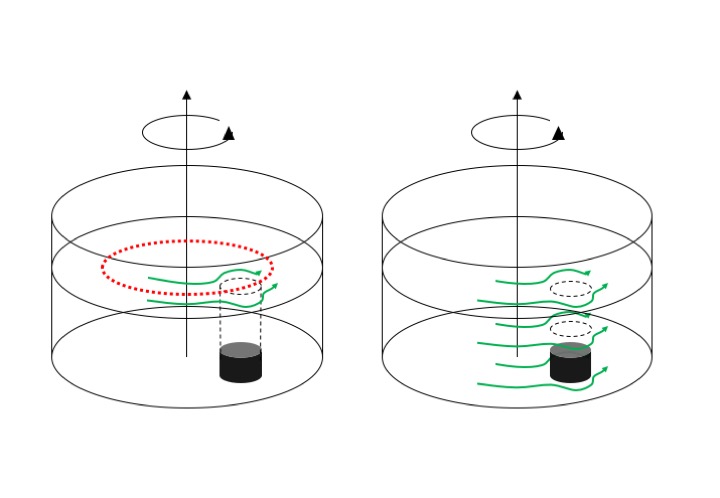For both of my tank experiment projects, in Bergen and in Kiel, we want to develop a Taylor column demonstration. So here are my notes on the setup we are considering, but before actually having tried it.
Since water under rotation becomes rigid, funny things can happen. For example if a current in a rotating system hits an obstacle, even if the obstacle isn’t high at all relative to the water depth, the current has to move around the obstacle as if it reached all the way from the bottom to the surface. This can be shown in a rotating tank, so of course that’s what we are planning to do!
We are following the Weather in a Tank instructions:
- rotating our tank at 5rpm with the obstacle in the water until solid body rotation is reached (We know that solid body rotation is reached if paper bits distributed on surface all rotate at same rate as the tank).
- change the rotation rate a little (they suggest as little as -0.1 rpm) so water moves relative to tank and obstacle, i.e. we have created a current flowing in the rotating system.
As the current meets the obstacle, columns of water have to move around the obstacle as if it went all the way from the bottom to the surface. This is made visible by the paper bits floating on the surface that are also moving around the area where the obstacle is located, even though the obstacle is far down at the bottom of the tank and there is still plenty of water over it.
In the sketch below, the red dotted line indicates a concentric trajectory in the tank that would go right across the obstacle, the green arrows indicate how the flow is diverted around the Taylor column that forms over the obstacle throughout the whole water depth.

Or at least that’s what I hope will happen! I am always a little sceptical with tank experiments that require changing the rotation rate, since that’s what we do to show both turbulence and Ekman layers, neither of which we want to prominently happen in this case here. On the other hand, we are supposed to be changing the rotation rate only very slightly, and in the videos I have seen it did work out. But this is an experiment that is supposedly difficult to run, so we will see…
I also came across about a super cool extra that Robbie Nedbor-Gross and Louis Dumas implemented in this demo: a moving Taylor column! when the obstacle is moved, the Taylor column above it moves with it. Check out their video, it is really impressive! However I think implementing this feature isn’t currently very high on my list of priorities. But it would be fun!

This expt works really well, and is not too turbulent at all. I use a rock that is almost like a half-sphere, and that works fine. I’d actually avoid something with sharp edges as that will have more flow separation. Don’t expect anything useful over the object though, its the stretched eddy that forms downstream that shows the effect most clearly. It is too turbulent to show the one on top of the bump. For bonus points, spin the table the other way and see the vortex have the right sign when you repeat the expt.
I’ve never tried to move the object as that’d require some sort of rotating contraption. Could be cool though!
Hi Jody! Thanks for commenting! That sounds very encouraging, and avoiding the sharp edges is really helpful advice. I am super excited to try this experiment very soon :-)
We have a hockey puck which I think came with the MIT kit and yes the experiment works pretty well. We have a camera co-rotating with the tank and a video screen next to the tank. Its hard to see the relatively subtle motion of the paper pellets around the obstacle from a non-rotating frame, but pretty clear in the video feed.
Awesome, thanks! Can’t wait to try! :-)